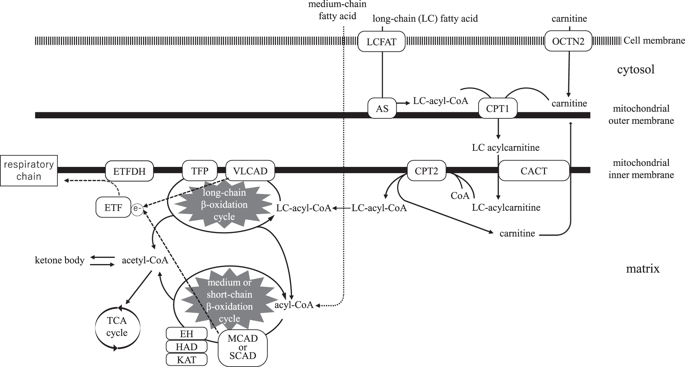当前位置:
X-MOL 学术
›
J. Hum. Genet.
›
论文详情
Our official English website, www.x-mol.net, welcomes your
feedback! (Note: you will need to create a separate account there.)
Management and diagnosis of mitochondrial fatty acid oxidation disorders: focus on very-long-chain acyl-CoA dehydrogenase deficiency.
Journal of Human Genetics ( IF 2.6 ) Pub Date : 2019-Feb-01 , DOI: 10.1038/s10038-018-0527-7 Kenji Yamada 1 , Takeshi Taketani 1
Journal of Human Genetics ( IF 2.6 ) Pub Date : 2019-Feb-01 , DOI: 10.1038/s10038-018-0527-7 Kenji Yamada 1 , Takeshi Taketani 1
Affiliation

|
Mitochondrial fatty acid oxidation disorders (FAODs) are caused by defects in β-oxidation enzymes, including very long-chain acyl-CoA dehydrogenase (VLCAD), trifunctional protein (TFP), carnitine palmitoyltransferase-2 (CPT2), carnitine-acylcarnitine translocase (CACT) and others. During prolonged fasting, infection, or exercise, patients with FAODs present with hypoglycemia, rhabdomyolysis, cardiomyopathy, liver dysfunction, and occasionally sudden death. This article describes the diagnosis, newborn screening, and treatment of long-chain FAODs with a focus on VLCAD deficiency. VLCAD deficiency is generally classified into three phenotypes based on onset time, but the classification should be comprehensively determined based on genotype, residual enzyme activity, and clinical course, due to a lack of apparent genotype-phenotype correlation. With the expansion of newborn screening for FAODs, several issues have arisen, such as missed detection, overdiagnosis (including detection of benign/asymptomatic type), and poor prognosis of the neonatal-onset form. Meanwhile, dietary management and restriction of exercise have been unnecessary for patients with the benign/asymptomatic type of VLCAD deficiency with a high fatty acid oxidation flux score. Although L-carnitine therapy for VLCAD/TFP deficiency has been controversial, supplementation with L-carnitine may be accepted for CPT2/CACT and multiple acyl-CoA dehydrogenase deficiencies. Recently, a double-blind, randomized controlled trial of triheptanoin (seven-carbon fatty acid triglyceride) versus trioctanoin (regular medium-chain triglyceride) was conducted and demonstrated improvement of cardiac functions on triheptanoin. Additionally, although the clinical efficacy of bezafibrate remains controversial, a recent open-label clinical trial showed efficacy of this drug in improving quality of life. These drugs may be promising for the treatment of FAODs, though further studies are required.
中文翻译:

线粒体脂肪酸氧化紊乱的管理和诊断:重点在于长链酰基辅酶A脱氢酶缺乏症。
线粒体脂肪酸氧化失调(FAOD)是由β-氧化酶的缺陷引起的,包括超长链酰基辅酶A脱氢酶(VLCAD),三功能蛋白(TFP),肉碱棕榈酰转移酶2(CPT2),肉碱-酰基肉碱转位酶( CACT)等。在长时间的禁食,感染或运动期间,患有FAOD的患者会出现低血糖,横纹肌溶解,心肌病,肝功能障碍,并偶尔猝死。本文介绍了长链FAOD的诊断,新生儿筛查和治疗,重点是VLCAD缺乏症。VLCAD缺乏症通常根据发病时间分为三种表型,但由于缺乏明显的基因型-表型相关性,因此应根据基因型,残留酶活性和临床病程全面确定分类。随着对FAOD的新生儿筛查的扩大,出现了一些问题,例如漏检,过度诊断(包括良性/无症状类型的检测)以及新生儿发病形式的预后不良。同时,对于脂肪酸氧化通量评分高的良性/无症状型VLCAD缺乏症的患者,饮食管理和运动限制是不必要的。尽管针对VLCAD / TFP缺乏症的L-肉碱疗法一直存在争议,但对于CPT2 / CACT和多种酰基辅酶A脱氢酶缺乏症,可以接受补充L-肉碱。最近,进行了三庚酸甘油酯(七碳脂肪酸甘油三酸酯)与三辛酸甘油酯(常规中链甘油三酸酯)的双盲,随机对照试验,证明了三庚酸甘油酯的心脏功能得到改善。此外,尽管苯扎贝特的临床疗效尚存争议,但最近的一项开放标签临床试验表明,该药物可改善生活质量。尽管需要进一步研究,但这些药物可能有望用于治疗FAOD。
更新日期:2019-01-26
中文翻译:

线粒体脂肪酸氧化紊乱的管理和诊断:重点在于长链酰基辅酶A脱氢酶缺乏症。
线粒体脂肪酸氧化失调(FAOD)是由β-氧化酶的缺陷引起的,包括超长链酰基辅酶A脱氢酶(VLCAD),三功能蛋白(TFP),肉碱棕榈酰转移酶2(CPT2),肉碱-酰基肉碱转位酶( CACT)等。在长时间的禁食,感染或运动期间,患有FAOD的患者会出现低血糖,横纹肌溶解,心肌病,肝功能障碍,并偶尔猝死。本文介绍了长链FAOD的诊断,新生儿筛查和治疗,重点是VLCAD缺乏症。VLCAD缺乏症通常根据发病时间分为三种表型,但由于缺乏明显的基因型-表型相关性,因此应根据基因型,残留酶活性和临床病程全面确定分类。随着对FAOD的新生儿筛查的扩大,出现了一些问题,例如漏检,过度诊断(包括良性/无症状类型的检测)以及新生儿发病形式的预后不良。同时,对于脂肪酸氧化通量评分高的良性/无症状型VLCAD缺乏症的患者,饮食管理和运动限制是不必要的。尽管针对VLCAD / TFP缺乏症的L-肉碱疗法一直存在争议,但对于CPT2 / CACT和多种酰基辅酶A脱氢酶缺乏症,可以接受补充L-肉碱。最近,进行了三庚酸甘油酯(七碳脂肪酸甘油三酸酯)与三辛酸甘油酯(常规中链甘油三酸酯)的双盲,随机对照试验,证明了三庚酸甘油酯的心脏功能得到改善。此外,尽管苯扎贝特的临床疗效尚存争议,但最近的一项开放标签临床试验表明,该药物可改善生活质量。尽管需要进一步研究,但这些药物可能有望用于治疗FAOD。


















































 京公网安备 11010802027423号
京公网安备 11010802027423号